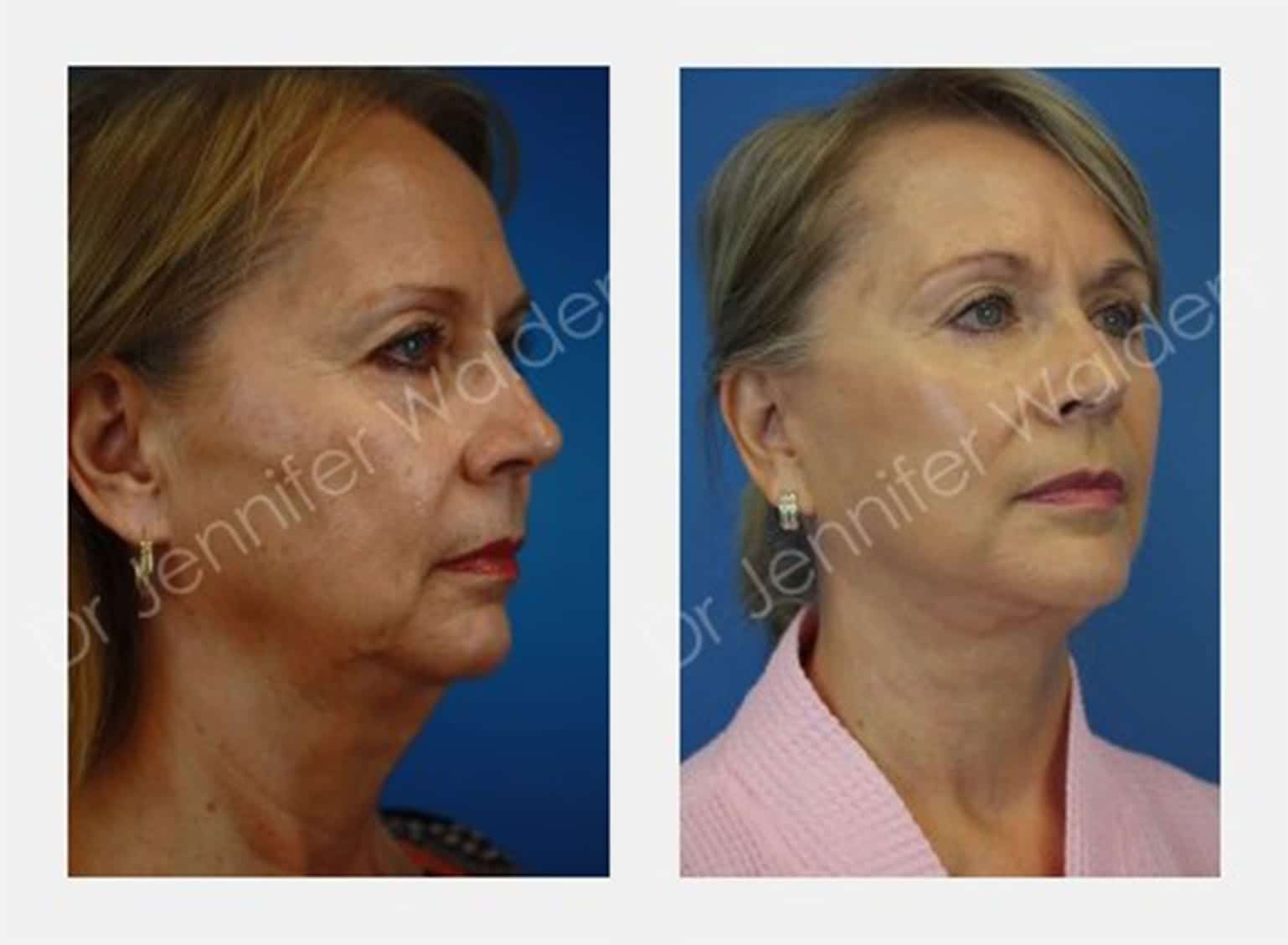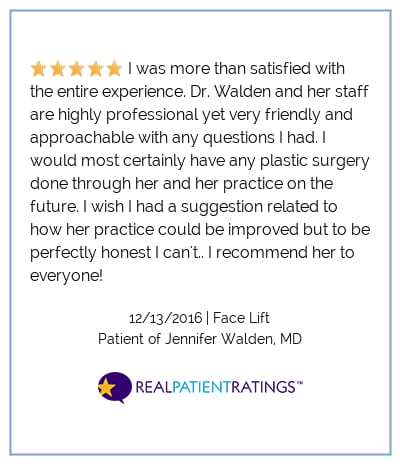
In time, gravity, sun exposure and the stresses of daily life take their toll on our faces and necks. Deep creases appear beside the mouth, the jaw line slackens and becomes jowly, and the neck develops loose folds and fat deposits. Facelifts counteract these signs of aging by tightening muscle, removing fat and trimming excess skin, giving your face a fresher, youthful look. After surgery, some patients look 10-15 years younger.
What Can a Facelift Do for Me?

Facelifts, technically known as rhytidectomies (literally, “removal of wrinkles”), rejuvenate the mid-to-lower face and neck. Facelifts are most effective for patients who want to correct:
- Midface sagging
- Deep creases under the eyes
- Deep creases between the nose and mouth (nasolabial folds)
- Jowls due to loss of muscle tone
- Sagging areas of fat
- Loose skin and fat under the chin and jaw
Facelift Before & After

What Won’t a Facelift Correct?
Facelifts can produce a dramatic improvement in appearance for patients with the problems mentioned above. However, facelifts do not stop the aging process; in time, signs of aging will gradually appear once again.
Further, facelifts will not rejuvenate the brow, eyelids, nose, and some of the midface. Patients who want to improve these areas may consider combining a facelift with a brow lift or eyelid surgery (blepharoplasty).
Injectable soft-tissue fillers, facial implants and skin resurfacing can also enhance the effects of a facelift.
Am I a Good Candidate for a Facelift?
The best candidates for rhytidectomy:
- Wish to improve one or more of the signs of aging indicated above
- Are men or women whose faces have begun to sag, but whose skin still has some elasticity
- Are generally healthy
- Do not smoke
- Have realistic expectations
- Are considering a facelift for personal reasons, not because someone else is pressuring them to do so
During your consultation, Dr. Walden of Austin TX will discuss whether a facelift is right for you.

The Facelift Procedure
Facelifts are typically outpatient procedures, and may be performed in an office-based facility, surgery center or hospital. Patients may have a choice of IV sedation or general anesthesia. The procedure takes about two hours.
The way a facelift is performed varies depending on the surgeon, the patient’s facial structure and the extent of correction desired. The three most common incision techniques are:
- Traditional facelift: The “full” facelift for rejuvenating the face, jowls and neck, including fat sculpting, lifting and repositioning of muscle and deeper tissues, and skin trimming and redraping. The incision begins at the temples and travels down to the front of the ear, around the earlobe, and behind the ear to the lower scalp at the hairline. Sometimes, another incision is made under the chin.
- Limited-incision facelift: For limited rejuvenation around the eyes and mouth, including nasolabial folds and other deep creases. Short incisions are made at the temples and around the ear, and, possibly, in the lower eyelids and/or under the upper lip.
- Neck lift: A neck lift concentrates on jowls, loose skin on the neck, and fat under the chin. The incision is made around the ear lobe and behind the ear to the lower scalp.
In all three methods, incisions are closed with stitches or tissue glue. Scars are hidden in the hairline and natural contours of the face.
Can a Facelift Be Combined With Other Procedures?
Facelifts are often combined with additional procedures. For example, dermal fillers may be introduced into the cheeks to add volume after skin and tissue have been lifted. Laser or light treatment, chemical peels, and microneedling are all excellent treatments that may be performed on an ongoing basis after facelift surgery to maintain the natural production of collagen for firmer, softer skin.
Does a Facelift Include a Neck Lift?
The facial tissue that droops with age affects the appearance of the neck. Therefore, most facelifts also address the neck. In order to achieve the most natural-looking results, the tissue on the lower face is lifted upward while the tissue on the neck is lifted back and up toward the ears. Every situation is unique. Dr. Walden discusses the details of each lift during the consultation visit.
A midface lift restores youthful vitality to the midface, lifting the cheeks and smoothing smile lines to achieve a natural rejuvenated look without the need to undergo a full facelift. Midface lifts are ideal for reducing puffiness under the eyes, improving the contour of the upper cheeks, and correcting nasolabial folds. Incisions are small and hidden in the eyelids or in the mouth. Midface lifts are often performed in conjunction with lower-lid blepharoplasty to rejuvenate the area around the eyes, or with implants to accentuate the cheeks.
After your rhytidectomy, Dr. Walden will wrap the incisions in bandages and may place drainage tubes in the area. The tubes will be taken out the next day when your hair will be carefully washed. If surgical clips are used to hold the incisions closed, they will be removed one week after the facelift along with your stitches.
At first, you may experience swelling, numbness, bruising, and a feeling of tightness or tension in the face and neck. Your face may look uneven or distorted, and your facial muscles may feel stiff. Most of these usually resolve within 3-6 weeks, and sensation typically returns to normal within a few months. Scars become less red, raised, lumpy or itchy in time.
Many patients return to work by the third week. Camouflage cosmetics can be used to minimize the appearance of bruising.
You should be gentle with your skin and hair as you recover. Men may need to shave behind the neck and ears where areas of beard-growing skin have moved.
Incisions are made discreetly in natural creases when possible to reduce the appearance of scars after facelift surgery. Short incisions may also be made in front of the ear, behind the ear, or just under the chin to lift and trim tissue on the upper neck.
There are several ways in which the risk of noticeable scarring can be reduced. Patients are encouraged to stop smoking at least six weeks before any surgical procedure to support the body’s natural healing process. Certain topical solutions may also be applied during recovery to promote optimal healing where incisions have been made. We are happy to discuss tips for scar reduction with you before or after your facelift.
We schedule follow up visits as needed to evaluate how you are healing and to remove sutures. Any further treatment after facelift surgery is entirely personal and can be discussed at any time in your rejuvenation journey. Complementary treatments such as laser skin resurfacing and injectables may be performed as they meet your needs and preferences, usually after swelling has substantially decreased.
Facelift procedures are very safe and usually have no side effects beyond the expected bruising and swelling. However, there is the potential for complications such as infection, bleeding, diminished muscle function, poor scarring, hair loss where incisions are made, and asymmetry.

Patient Reviews
Check out this 5-star rating from a highly satisfied patient!
“I was more than satisfied with the entire experience. Dr. Walden and her staff are highly professional yet very friendly and approachable with any questions I had. I would most certainly have any plastic surgery done through her and her practice in* the future. I wish I had a suggestion related to how her practice could be improved but to be perfectly honest I can’t.. I recommend her to everyone!” Face Lift Patient of Jennifer Walden, MD





